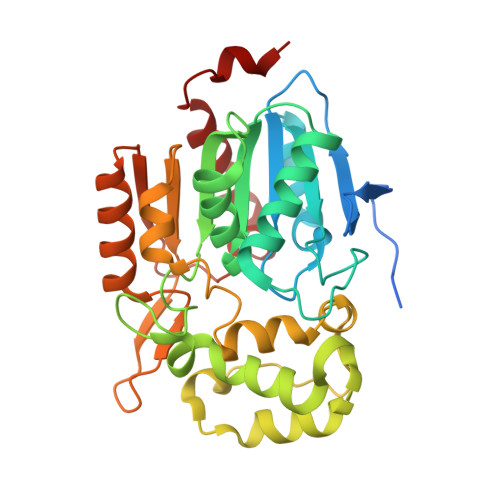Bacterial Lactonases ZenA with Noncanonical Structural Features Hydrolyze the Mycotoxin Zearalenone.
Fruhauf, S., Puhringer, D., Thamhesl, M., Fajtl, P., Kunz-Vekiru, E., Hobartner-Gussl, A., Schatzmayr, G., Adam, G., Damborsky, J., Djinovic-Carugo, K., Prokop, Z., Moll, W.D.(2024) ACS Catal 14: 3392-3410
- PubMed: 38449531
- DOI: https://doi.org/10.1021/acscatal.4c00271
- Primary Citation of Related Structures:
8CLN, 8CLO, 8CLP, 8CLQ, 8CLT, 8CLU, 8CLV - PubMed Abstract:
Zearalenone (ZEN) is a mycoestrogenic polyketide produced by Fusarium graminearum and other phytopathogenic members of the genus Fusarium . Contamination of cereals with ZEN is frequent, and hydrolytic detoxification with fungal lactonases has been explored. Here, we report the isolation of a bacterial strain, Rhodococcus erythropolis PFA D8-1, with ZEN hydrolyzing activity, cloning of the gene encoding α/β hydrolase ZenA encoded on the linear megaplasmid pSFRL1, and biochemical characterization of nine homologues. Furthermore, we report site-directed mutagenesis as well as structural analysis of the dimeric ZenA Re of R. erythropolis and the more thermostable, tetrameric ZenA Scfl of Streptomyces coelicoflavus with and without bound ligands. The X-ray crystal structures not only revealed canonical features of α/β hydrolases with a cap domain including a Ser-His-Asp catalytic triad but also unusual features including an uncommon oxyanion hole motif and a peripheral, short antiparallel β-sheet involved in tetramer interactions. Presteady-state kinetic analyses for ZenA Re and ZenA Scfl identified balanced rate-limiting steps of the reaction cycle, which can change depending on temperature. Some new bacterial ZEN lactonases have lower K M and higher k cat than the known fungal ZEN lactonases and may lend themselves to enzyme technology development for the degradation of ZEN in feed or food.
Organizational Affiliation:
dsm-firmenich Animal Nutrition and Health R&D Center Tulln, Technopark 1, Tulln 3430, Austria.















